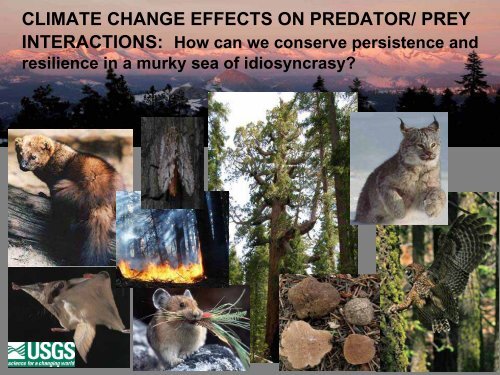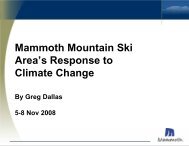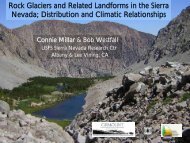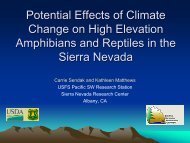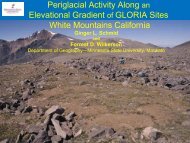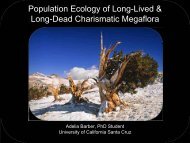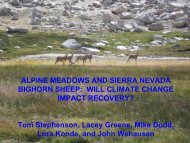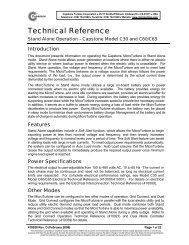climate change effects on predator/prey interactions: how can we ...
climate change effects on predator/prey interactions: how can we ...
climate change effects on predator/prey interactions: how can we ...
Create successful ePaper yourself
Turn your PDF publications into a flip-book with our unique Google optimized e-Paper software.
CLIMATE CHANGE EFFECTS ON PREDATOR/ PREY<br />
INTERACTIONS: How <strong>can</strong> <strong>we</strong> c<strong>on</strong>serve persistence and<br />
resilience in a murky sea of idiosyncrasy
Global <str<strong>on</strong>g>climate</str<strong>on</strong>g> <str<strong>on</strong>g>change</str<strong>on</strong>g><br />
• What is changing<br />
• Can <strong>we</strong> relate GLOBAL <str<strong>on</strong>g>change</str<strong>on</strong>g> patterns<br />
to LOCAL systems<br />
– Landscape variables measured at broad scale<br />
– animals usually measured at local scale<br />
Everything is c<strong>on</strong>nected so at some<br />
point Natural Selecti<strong>on</strong> should elicit<br />
a resp<strong>on</strong>se in… everything.
Mean m<strong>on</strong>thly minimum temperature: Yosemite<br />
Valley, CA 1905 - 2007<br />
Loss of 3<br />
freezing<br />
m<strong>on</strong>ths<br />
(Nov,<br />
Mar, Apr)<br />
Moritz et al. 2008; Western regi<strong>on</strong>al <str<strong>on</strong>g>climate</str<strong>on</strong>g> center<br />
Leading to:<br />
• Higher variability in annual snowpack<br />
• Earlier snow melt<br />
• Decreased stream flows
Research <strong>on</strong> <str<strong>on</strong>g>effects</str<strong>on</strong>g> of <str<strong>on</strong>g>climate</str<strong>on</strong>g> <str<strong>on</strong>g>change</str<strong>on</strong>g><br />
Models worldwide attempt to model animal distributi<strong>on</strong>s <strong>on</strong><br />
predicted habitat maps<br />
Predicti<strong>on</strong>s:<br />
1. Few species go extinct<br />
a. unsuitable c<strong>on</strong>diti<strong>on</strong>s for persistence<br />
b. out competed by invading/pi<strong>on</strong>eering species<br />
2. Many species will dramatically c<strong>on</strong>tract in distributi<strong>on</strong><br />
a. increased fragmentati<strong>on</strong><br />
b. reduced resilience in populati<strong>on</strong> dynamics (more vulnerable to<br />
extincti<strong>on</strong> with perturbati<strong>on</strong>s)<br />
3. Others will extend their range<br />
a. usually at the expense of another species (e.g. the alpine<br />
chipmunk being displaced by lodgepole chipmunk)<br />
Community compositi<strong>on</strong> is going to <str<strong>on</strong>g>change</str<strong>on</strong>g>
Animals adapt <strong>on</strong> a species level<br />
Summary of Grinnell resampling small<br />
mammal survey (Moritz et al. 2008)<br />
Range<br />
Expansi<strong>on</strong><br />
Range<br />
C<strong>on</strong>tracti<strong>on</strong><br />
No Change<br />
Number of<br />
species<br />
3 spp Higher<br />
2 spp Lo<strong>we</strong>r<br />
6 spp Higher<br />
1 spp Lo<strong>we</strong>r<br />
12 spp<br />
1 spp Both<br />
2 spp Both<br />
• No pattern or mechanism as to who’s range c<strong>on</strong>tracted or expanded<br />
• Each small mammal guild is represented in all categories<br />
• ALL of these species are important <strong>prey</strong> items in the Sierra Nevada
C<strong>on</strong>flicting results in Sierra Nevada<br />
Within Genus (Neotoma spp.; Moritz et al. 2008)<br />
• Large-eared woodrat s<strong>how</strong>ed no <str<strong>on</strong>g>change</str<strong>on</strong>g><br />
in distributi<strong>on</strong> from 1920 to 2005<br />
• Bushy-tailed woodrat s<strong>how</strong>ed signifi<strong>can</strong>t<br />
<str<strong>on</strong>g>change</str<strong>on</strong>g><br />
Within Species (bushy-tailed woodrat)<br />
• One study s<strong>how</strong>ed range expansi<strong>on</strong> (East slope:<br />
McD<strong>on</strong>ald and Brown 1992)<br />
• Another study s<strong>how</strong>ed range c<strong>on</strong>tracti<strong>on</strong> (West<br />
slope: Moritz et al. 2008)
Idiosyncrasy in our thinking and our data<br />
C<strong>on</strong>flicting paradigms<br />
1. Ambient temperature and animal physiological<br />
c<strong>on</strong>straints influence species susceptibility to<br />
extincti<strong>on</strong> (McD<strong>on</strong>ald and Brown 1992)<br />
• True for species c<strong>on</strong>strained in distributi<strong>on</strong>, e.g. high<br />
m<strong>on</strong>tane mammals<br />
2. Animal distributi<strong>on</strong>s influenced by habitat <str<strong>on</strong>g>change</str<strong>on</strong>g>s<br />
not physiological c<strong>on</strong>straints (Johnst<strong>on</strong> and Schmitz 1997, Moritz et al. 2008)<br />
• Habitat quality directly linked to populati<strong>on</strong> dynamics for<br />
herbivores, aka PREY<br />
• Prey populati<strong>on</strong> dynamics highly correlated to <strong>predator</strong><br />
populati<strong>on</strong> dynamics
Classic <strong>predator</strong>-<strong>prey</strong> populati<strong>on</strong> cycles: snowshoe<br />
hare and Canada lynx<br />
Trapping records from Huds<strong>on</strong> Bay, Canada<br />
Highly correlated c<strong>on</strong>necti<strong>on</strong>s in the <strong>predator</strong>-<strong>prey</strong> system<br />
- If something happens to <strong>on</strong>e, it throws off the other<br />
- amplitude variability is positively related to probability of<br />
extincti<strong>on</strong>
Prey populati<strong>on</strong> cyclicity<br />
Cyclicity = amplitude and frequency of cycles<br />
• Increases with latitude and snow cover.<br />
• Decreases with generalist <strong>predator</strong>s<br />
• Increases with specialist <strong>predator</strong>s<br />
• Prey food source reliability related to <strong>prey</strong><br />
cyclicity (e.g. acorn crops cycle)
Spotted owl <strong>prey</strong> annual abundance patterns<br />
120<br />
100<br />
flying squirrel<br />
deer mouse<br />
Prey abundance<br />
80<br />
60<br />
40<br />
20<br />
Rosenberg et al. 2003<br />
0<br />
1986 1988 1990 1992 1994 1996 1998<br />
Year
Prey abundance and owl reproductive success<br />
Prey abundance<br />
120<br />
100<br />
80<br />
60<br />
40<br />
20<br />
flying squirrel<br />
deer mouse<br />
spotted owl reproducti<strong>on</strong><br />
2.0<br />
1.5<br />
1.0<br />
0.5<br />
# of owlets / owl pair<br />
0<br />
Rosenberg et al. 2003<br />
1987 1988 1989 1990 1991 1992 1993 1994 1995 1996<br />
Year<br />
0.0
northern goshawk<br />
barred owl<br />
(invader)<br />
great horned owl<br />
raven<br />
Spotted owl<br />
Habitat and diet<br />
SPECIALISTS<br />
passerine birds<br />
shrews<br />
bats<br />
flying squirrel<br />
deer mice<br />
chipmunks<br />
seeds<br />
grasses<br />
woodrats<br />
forbs<br />
voles<br />
pollen<br />
beetles<br />
moths<br />
insects<br />
lichen<br />
fungi<br />
trees<br />
detritus<br />
shrubs<br />
leaves
Spotted Owl Diets: Yosemite<br />
Woodrat = also important <strong>prey</strong> species<br />
Flying<br />
squirrels<br />
Woodrats<br />
Closed <strong>can</strong>opy<br />
Open <strong>can</strong>opy
Flying squirrel resp<strong>on</strong>se to <str<strong>on</strong>g>climate</str<strong>on</strong>g> <str<strong>on</strong>g>change</str<strong>on</strong>g>:<br />
1. If forest dries out, flying squirrels follow truffles c<strong>on</strong>fined<br />
to riparian areas due to their <strong>prey</strong>’s (truffles) associati<strong>on</strong><br />
with high soil moisture<br />
2. Predators of flying squirrels follow <strong>prey</strong> to riparian areas<br />
3. C<strong>on</strong>nectivity to <strong>prey</strong> refuge areas, high <strong>prey</strong> abundance<br />
areas, and <strong>predator</strong> refuge areas<br />
- Will they cross n<strong>on</strong>-habitat patches<br />
4. Will <strong>predator</strong> survival decline
How does idiosyncratic <strong>prey</strong> resp<strong>on</strong>se<br />
affect the <strong>predator</strong><br />
• All woodrats equally preferred <strong>prey</strong><br />
• Predator (spotted owls) inhabitat a gradient of<br />
particular habitat structure (e.g., late seral forest)<br />
• Owls in <strong>on</strong>e habitat (100 – 85% <strong>can</strong>opy closure) may<br />
have declining woodrats (species that prefer<br />
closed <strong>can</strong>opy) while owls in another habitat (70<br />
– 60 % closure) see little <str<strong>on</strong>g>change</str<strong>on</strong>g> in woodrats<br />
(those that prefer open forest).<br />
Bushytailed<br />
woodrat<br />
Big-eared<br />
woodrat
How <strong>can</strong> <strong>we</strong> manage for spatial<br />
idiosyncrasy<br />
Prey and Predators need access to a<br />
mosaic of habitat types<br />
– habitat patches need to c<strong>on</strong>tain desired<br />
structure<br />
– Must be c<strong>on</strong>nectivity bet<strong>we</strong>en patches<br />
• Many species may not cross what they perceive<br />
as n<strong>on</strong>-habitat despite the size of the n<strong>on</strong>habitat<br />
patch<br />
• C<strong>on</strong>servati<strong>on</strong> areas may need to expand or<br />
reassess their borders to meet these habitat<br />
shifts
ADAPTIVE RESEARCH<br />
WORK TOGETHER<br />
• With no clear patterns of biological resp<strong>on</strong>ses<br />
to <str<strong>on</strong>g>climate</str<strong>on</strong>g> <str<strong>on</strong>g>change</str<strong>on</strong>g><br />
• Apply general framework for approaching<br />
research<br />
– Change focus as new informati<strong>on</strong> arises<br />
• Integrate different sciences may be<br />
important in obtaining the ans<strong>we</strong>rs <strong>we</strong> need<br />
to guide adaptive management policies
Adaptive Research Framework<br />
1. Prioritize species of c<strong>on</strong>cern (e.g., Ecology)<br />
a. Pika are habitat specialists and they <strong>can</strong>’t escape to<br />
higher ground!<br />
- vulnerable m<strong>on</strong>tane mammals if temperatures increase the<br />
predicted 3 0 C (McD<strong>on</strong>ald and Brown 1992)<br />
b. Keyst<strong>on</strong>e c<strong>on</strong>sumer: Pika influence alpine plant<br />
compositi<strong>on</strong>, reduce inter-specific competiti<strong>on</strong> in<br />
plants<br />
c. Many <strong>predator</strong>s c<strong>on</strong>sume pikas<br />
d. Loss of pika leads to trophic cascades
Adaptive Research Framework<br />
2. Prioritize mechanisms of <str<strong>on</strong>g>change</str<strong>on</strong>g><br />
affecting species (Physiology and botany)<br />
a. Pika are limited in physiological ability to deal<br />
with heat<br />
- Increased temps reduce foraging times<br />
b. Reduced snow pack <str<strong>on</strong>g>change</str<strong>on</strong>g> plant compositi<strong>on</strong><br />
- Plant community pika not evolved to exploit <br />
c. Lack of livestock grazing associated with higher<br />
probability of local persistence (Beever et al. 2003)
Adaptive Research Framework<br />
3. Identify habitat features resilient or<br />
resistant to <str<strong>on</strong>g>change</str<strong>on</strong>g> (Geology)<br />
a. Rock glaciers and rock-ice features<br />
• Interstitial micro<str<strong>on</strong>g>climate</str<strong>on</strong>g> remains cool in summer<br />
(Delaloye and Lambiel 2005)<br />
• Pika refuge with disappearing snow patches (Millar et<br />
al. 2007)<br />
Rock glacier
Salient points<br />
GIVE ANIMALS ROOM TO ROAM<br />
As habitat <str<strong>on</strong>g>change</str<strong>on</strong>g>s:<br />
Prey need to find<br />
suitable habitat and<br />
the <strong>predator</strong>s need to<br />
find <strong>prey</strong> as they are<br />
seeking shifting<br />
habitats
Salient points<br />
ADAPTIVE RESEARCH<br />
Integrate different sciences:<br />
knowledge diversity is important in obtaining<br />
the ans<strong>we</strong>rs <strong>we</strong> need to guide adaptive<br />
management policies


